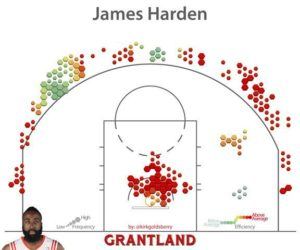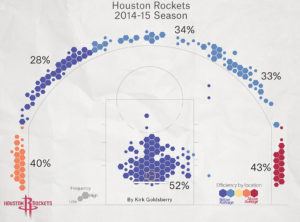Houston Rockets and “Moreyball”

The Houston Rockets used Data-Driven Decision making to become an Elite NBA Team
The pioneer of data analytics in the NBA and the founder of the MIT Sloan Conference, Daryl Morey took an unconventional approach to building an NBA team. However, after tremendous success over the past 7 years, his approach is quickly becoming the standard in the NBA.
Once nicknamed Dork Elvis by a famous sportswriter, Morey is a computer science major with a masters from MIT. He worked in consulting and has built his career on statistical analysis. The Oakland Athletics’ (baseball) Billy Beane is said to be the pioneer of “Moneyball” or sabermetrics (using data to identify undervalued players in sports). However, Beane was not the statistical mastermind behind the “Moneyball” process. Former Cleveland and then Oakland front office assistant John DePodesta was the data geek. Daryl Morey is the combination of Beane and DePodesta. He’s the data geek with a vision.
It took some time, but in Houston Morey managed to do something rare in sports: aligning the vision of the front office with the talent composition of the team and the preferred playing style of the coach. Houston now has the best record in the NBA this year and has been one of the 3 best teams in the league over the last 4 years. The first step in the process of building to their success was using data to define what that “vision” would be. Then he could fill in the rest.
Through deep analysis of game data, Morey identified his vision for how a basketball team should play. There are three main tenets to this vision
- Play fast: looking for shots early in the “shot clock.” Morey determined that playing at a torrid pace leads to more efficient offensive performance in today’s NBA. It also increases the number of possessions in a game, which statistically gives the more talented team a higher chance of winning (lower possession games lead to more anomalies in outcomes).
- Shoot only two (and a half) types of shots: there are a wide array of shots from all over the court that basketball players can practice and shoot in a game. Through analysis of years of data, Morey figured out that two (and a half) types shots are by far the most efficient – dunk/layups, foul shots (the half), and 3-pointers. Dunks/layups are shots right near the basket, they are the highest percentage shots. Everyone seems to know this but many teams often do not attack the basket as much as they should. Driving towards the basket also leads to more foul shots, which are also an incredibly efficient way to score basketball (that’s the half). 3-pointers are lower percentage shots, but they count for 50% more points. Therefore, if you can make 40% of your threes you are doing as well as a team that makes 50% of twos. In all of this Morey identified “midrange” shots, (shots that are neither near the basket nor behind the three point line) as the least efficient shot in basketball. Surprising to Morey, midrange shots were incredibly popular in the NBA. Morey essentially forbid his team from taking these shots, a move that was highly criticized by basketball purists as being too mechanical.
Shot charts for Houston’s best player and for Houston as a team (notice where all the shots are from)
Since Morey took over, the Rockets have been among league leaders in three pointers, layups, and free throws. Furthermore, the players he acquires fit the mold by being either great players who can both shoot and drive to the basket, or specialists who do one of the two very well.
- Defensive Flexibility – Morey recognized that the NBA was moving towards a more free-flowing game with very few traditional “Centers” who can only play down low. Therefore, Morey avoided spending money on these players and instead has focused on acquiring versatile athletes who can defend many positions on the floor. Consequently, Morey’s team is made up of a lot of guys who are average height (6’7 for the NBA) and play a “guard/forward” hybrid. This has been a very effective strategy. Many other teams have been slow to catch up to this phenomenon. Consequently Morey has been able to avoid spending money on expensive centers who would not fit his mold and have more money to spend on versatile players.
Morey’s vision took some time and thoughtful execution, but it has worked out better than anyone expected. In fact, according to a study by a PhD who specializes in statistical analysis, every team would be better off if they adopted Houston’s playing style. http://www.basketballanalyticsbook.com/2017/11/21/what-if-your-team-had-houstons-shot-selection/
Perhaps Morey’s greatest achievement has been using statistical analysis to understand where the value arbitrage opportunities are. According to Morey, “defense was more undervalued earlier in my career, now offense is more undervalued, so we’ve shifted our focus.” Morey understands this by building deep statistical models on team and player performance, and how each player impacts a game.
Because his vision is often contrarian to traditional scouting, Morey has been able to cheaply acquire players who fit his plans. Essentially, data has allowed Morey to get the players he wants at a discount because many other people do not see the same value in those players AND most general managers have not designed their team to play a style that fits the skills of that player. The result has been a smashing success.





Great post! It is very interesting that big data “Moneyball” approaches have been widely accepted in the MLB for over a decade, but were resisted in many of the other professional sports. For the NBA, I find the data analytics behind pace of play very interesting. As you noted, “lower possession games lead to more anomalies in outcomes”. Teams are embracing this change of tempo. The fast-break / transition pace of play is incredibly different from several decades ago.